Stop patching legacy tech and start compounding sales velocity.
Legacy configure price quote software creates an “invisible tax” on business growth through escalating maintenance costs, configuration complexity, integration challenges, and sales cycle delays. Organizations typically underestimate the true total cost of ownership by 40-60%, with hidden expenses including technical debt, talent shortages, and opportunity costs from slower quote-to-cash cycles. Modern CPQ solutions can reduce these hidden costs while accelerating revenue generation and improving sales efficiency for B2B companies evaluating CPQ software replacement options.
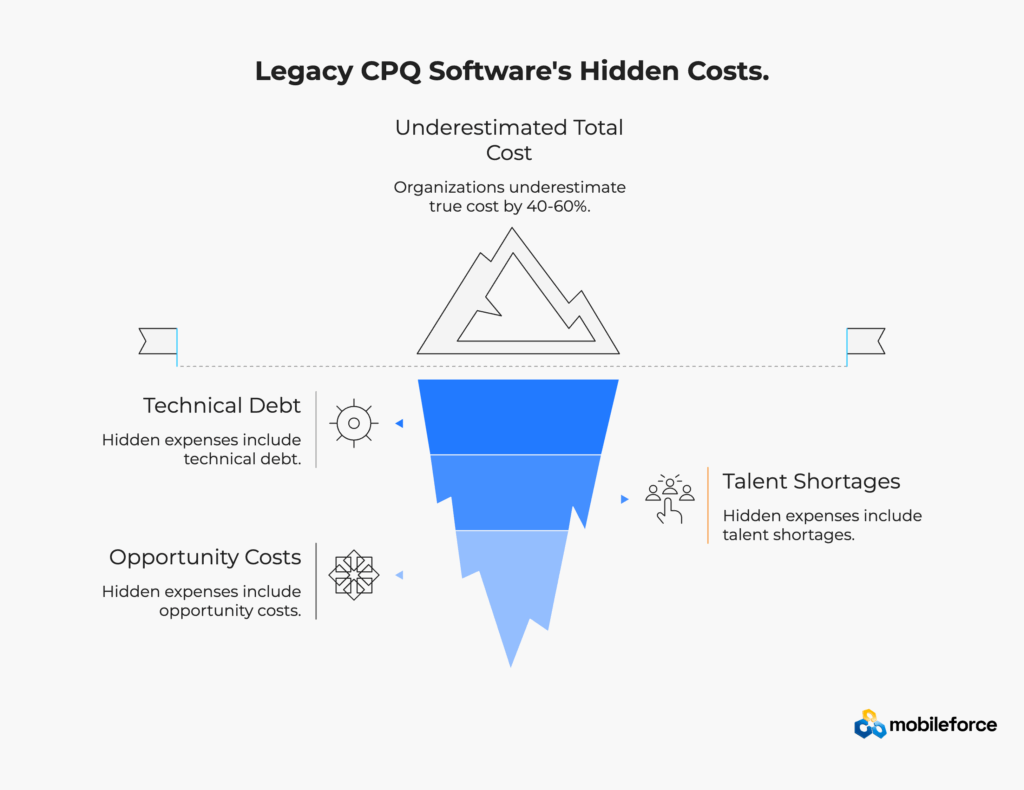
“We thought we were saving money by sticking with our legacy quoting system. Turns out, we were bleeding cash in ways we never tracked.” This sentiment echoes across boardrooms where CFOs discover their decades-old configure-price-quote (CPQ) systems have become financial anchors rather than sales enablers.
The numbers tell a stark story. According to recent industry analysis from McKinsey, organizations running legacy CPQ systems often experience total cost of ownership that’s 150-200% higher than anticipated. But here’s the kicker – most of these costs hide in plain sight.
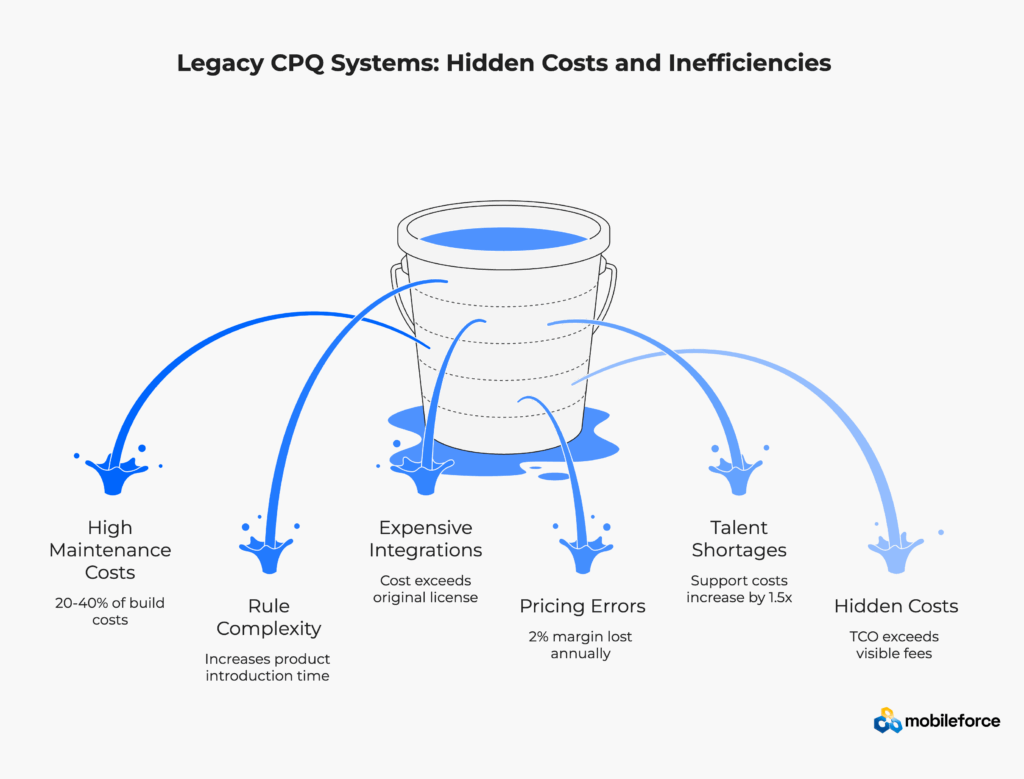
What are legacy CPQ systems? Legacy CPQ systems are heavily customized, on-premises solutions or aging vendor platforms that stopped evolving years ago. These outdated configure price quote platforms create what economists call “opportunity cost drag.” While companies focus on the obvious expenses like annual license renewals, the real financial damage happens in seven critical areas that rarely appear on budget reports.
Why do hidden CPQ costs matter? Hidden costs in CPQ software maintenance often outstrip visible budget line items by 40-60%. These costs include system integration challenges, configuration complexity, technical debt accumulation, talent shortage premiums, security vulnerabilities, compliance gaps, and sales productivity losses.
As businesses accelerate their digital transformation initiatives, the gap between modern quote-to-cash capabilities and legacy system limitations widens daily. Organizations clinging to outdated CPQ infrastructure aren’t just maintaining software – they’re subsidizing competitive disadvantage while competitors leverage modern CPQ platforms for sales acceleration.
Ready to uncover the true cost of your current quoting system? Schedule a comprehensive CPQ assessment to identify hidden cost drivers and optimization opportunities.

The maintenance trap springs slowly, then all at once. Legacy CPQ systems demand increasingly complex support as they age, creating a resource drain that compounds annually through system patches, custom scripting requirements, database optimization needs, and architectural reviews.
Industry research from Gartner indicates that home-grown CPQ systems typically require 20-40% of their original development cost each year just for maintenance. But that’s merely the baseline for configure price quote software maintenance expenses. As business requirements evolve and legacy systems struggle to adapt, maintenance costs escalate exponentially.
Consider the typical progression: Year one post-implementation brings minor bug fixes and user training. By year three, organizations need custom scripting for new product lines. Year five requires database optimization and server upgrades. Year seven demands complete architectural reviews as the system buckles under growing data loads and user demands.
The hidden multiplier effect emerges when organizations realize they’re allocating over half their sales operations and IT capacity to maintaining quoting logic instead of enabling new deals. Revenue-generating activities take a backseat to keeping the lights on.
Is your team spending more time maintaining your CPQ system than closing deals? Discover how modern platforms can redirect your resources from maintenance to revenue generation.
Modern CPQ platforms reverse this trend by shifting maintenance responsibilities to the vendor while providing continuous feature updates and security patches. The economics are compelling – organizations can redirect internal resources from system maintenance to revenue acceleration activities.
System Type | Maintenance Cost | Internal Resources | Update Frequency |
Legacy On-Premise | 30-40% of build cost | 2-3 FTE dedicated | Manual, quarterly |
Aging SaaS | 15-25% of license | 1-2 FTE partial | Vendor-dependent |
Modern Cloud CPQ | 5-10% of license | 0.5 FTE occasional | Automatic, monthly |
The talent shortage compounds these challenges. Legacy systems often run on outdated technology stacks requiring specialized knowledge that becomes scarcer and more expensive each year for CPQ software support teams.
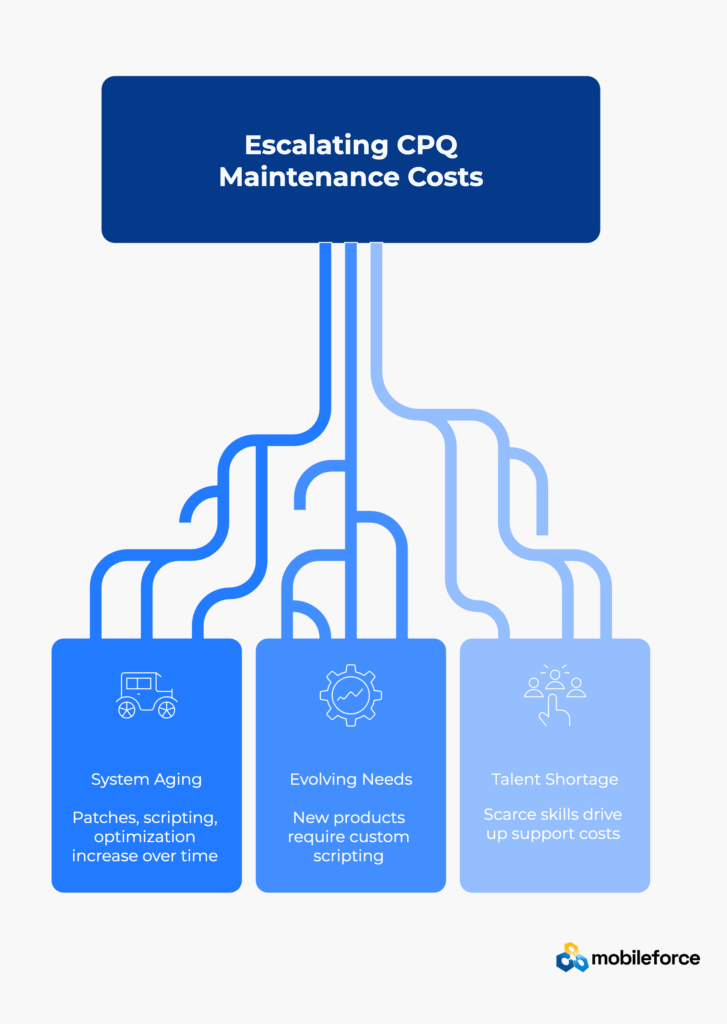
Configuration debt accumulates like compound interest – slowly at first, then overwhelmingly. Legacy CPQ systems develop rule hierarchies that grow organically, creating brittle configurations prone to errors and delays in the quote generation process.
The complexity spiral begins innocently. Sales teams request bundle pricing for key accounts. Product managers add new SKUs with unique discount structures. Regional managers demand localized approval workflows. Each addition seems reasonable in isolation, but collectively they create a labyrinthine rule structure that becomes increasingly difficult to maintain and modify.
Analysis from Harvard Business Review’s digital transformation research reveals that misconfigured quotes cost B2B organizations an average of $47,000 per error in lost deals and customer trust. More damaging is the cumulative effect – organizations with complex legacy CPQ rule sets take approximately three times longer to introduce new products because each addition impacts multiple existing configurations.
The documentation challenge exacerbates the problem. Legacy systems often lack comprehensive rule documentation, creating knowledge dependencies on specific individuals. When these key personnel leave, organizations face extended periods of reduced system functionality while new team members decode undocumented logic.
Configuration complexity also manifests in user experience degradation. Sales representatives struggle with quote accuracy when rule interactions aren’t transparent. The result? Longer sales cycles, increased support tickets, and reduced sales productivity for field sales teams and inside sales representatives.
Modern CPQ solutions address configuration complexity through visual rule builders, automated testing environments, and comprehensive audit trails. These tools enable business users to modify pricing logic without technical expertise while maintaining system integrity through no-code CPQ configuration.
Struggling with quote accuracy and configuration errors? Discover how modern CPQ platforms simplify rule management while maintaining pricing precision.
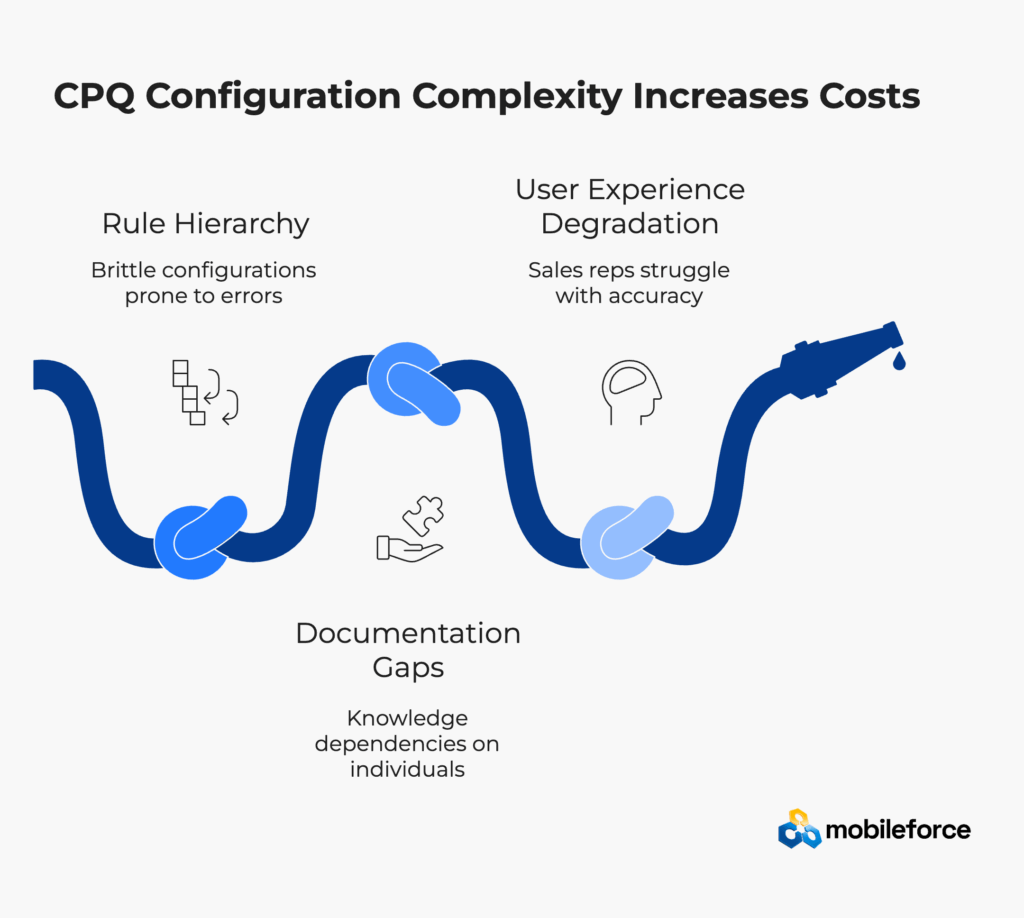
Integration nightmares multiply hidden costs faster than any other legacy CPQ factor. Outdated systems lack modern API-first architecture, forcing organizations to build custom middleware that often costs more than the original CPQ license for quote-to-cash integration requirements.
The integration tax manifests in multiple ways for enterprise software systems. Legacy CPQ systems typically require point-to-point connections with CRM, ERP, billing, and inventory management systems. Each integration demands custom development, ongoing maintenance, and careful orchestration to prevent data synchronization issues.
Integration Type | Legacy Approach | Development Time | Annual Maintenance | Failure Risk |
CRM Connection | Custom API build | 400-600 hours | $25k-40k | High |
ERP Integration | Middleware layer | 600-800 hours | $35k-50k | Very High |
Billing System | File-based sync | 200-400 hours | $15k-25k | Medium |
Inventory Management | Database queries | 300-500 hours | $20k-35k | High |
Reporting Platform | Data warehouse ETL | 500-700 hours | $30k-45k | Medium |
Data duplication becomes inevitable when systems can’t communicate effectively. Sales representatives maintain pricing information in multiple systems, creating version control nightmares and increasing error rates. Finance teams struggle with revenue recognition when quote data doesn’t flow seamlessly to billing systems for sales process automation.
The analytics impact is particularly costly. Organizations with disconnected CPQ systems can’t generate comprehensive quote-to-cash reports, limiting their ability to optimize pricing strategies and identify process bottlenecks. Decision-making suffers when data lives in silos rather than flowing through integrated business processes.
Research from MIT Sloan’s digital business transformation study indicates that enterprises spend an average of $3.2 million annually on integration projects, with legacy system modernization representing the largest category of investment.
Modern CPQ platforms eliminate integration complexity through pre-built connectors and standardized APIs. These solutions enable real-time data synchronization across business systems while reducing custom development requirements by 70-80%. Learn more about modern CPQ integration capabilities and how they streamline business processes.
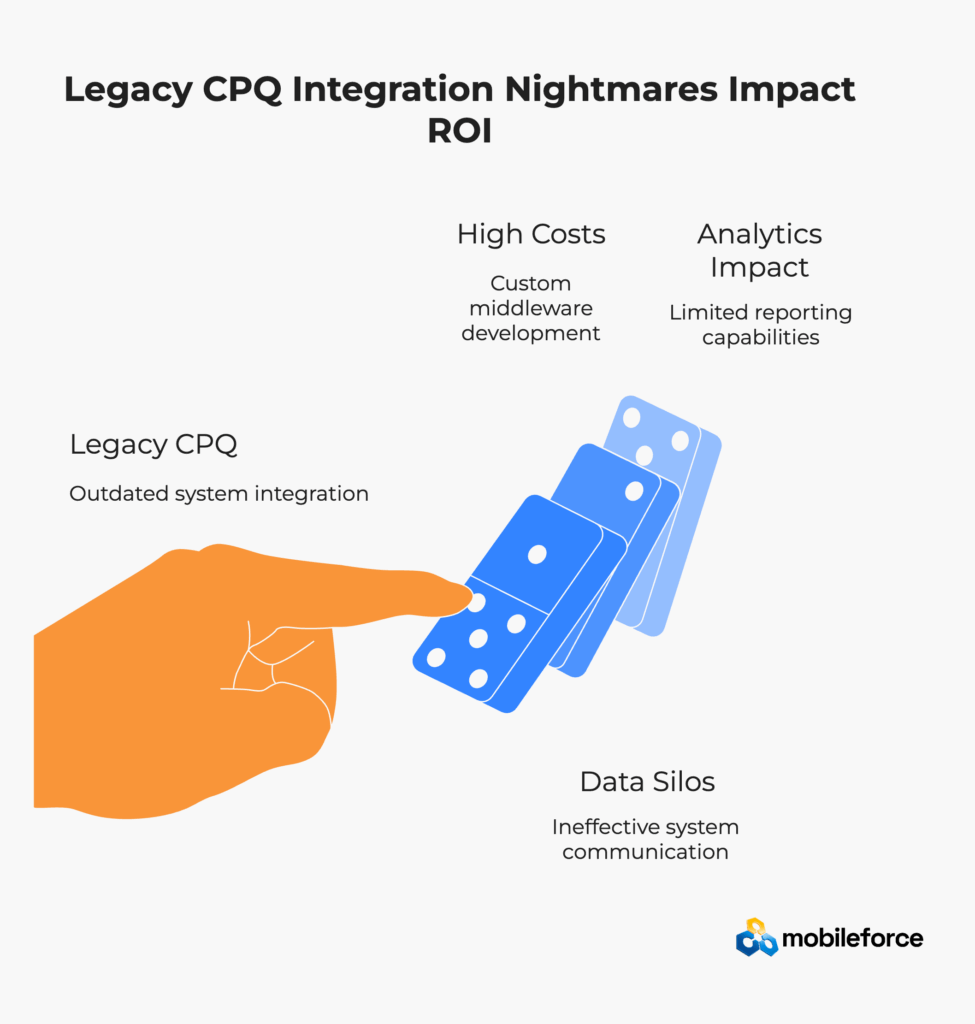
Time kills deals, and legacy CPQ systems are notorious time thieves. Slow quote generation, manual approval processes, and inflexible workflows extend sales cycles and reduce win rates in measurably expensive ways for B2B sales organizations.
The opportunity cost calculation is straightforward but often overlooked. When quote generation takes days instead of hours, competitors gain windows to advance their proposals. Deloitte’s sales acceleration research shows that organizations responding to RFPs within 24 hours win 60% more deals than those taking longer than 48 hours.
Legacy CPQ systems create multiple friction points that compound sales cycle delays:
Losing deals to faster competitors? Learn how modern CPQ solutions can cut your quote-to-order time by 60% or more.
The cumulative impact is substantial. Organizations with streamlined modern CPQ systems report quote-to-order time reductions of 60% or more in their first year post-implementation. This improvement translates directly to revenue acceleration and improved sales productivity.
Sales representative frustration compounds the problem. Complex legacy systems require extensive training and create user experience friction that reduces selling time. High-performing sales professionals often avoid complex deals when the quoting process becomes too cumbersome.
The competitive disadvantage multiplies in fast-moving markets. Companies that can generate accurate quotes quickly while competitors struggle with legacy systems gain significant advantages in deal velocity and customer satisfaction for competitive deal situations.

The skills gap for legacy CPQ systems creates a vicious cycle of increasing costs and decreasing capabilities. As technology evolves, the talent pool for maintaining outdated systems shrinks while costs escalate for specialized CPQ expertise.
Technical debt accumulates in several forms within legacy CPQ environments:
Code Complexity: Years of customizations create spaghetti code that’s difficult to understand and modify. New developers require months to become productive, and simple changes often have unexpected consequences across the system.
Documentation Gaps: Legacy systems frequently lack comprehensive documentation, creating knowledge dependencies on individual contributors. This tribal knowledge becomes a business risk when key personnel leave the organization.
Platform Obsolescence: Older CPQ systems often run on deprecated technology stacks with limited vendor support. Finding developers familiar with these platforms becomes increasingly difficult and expensive.
Industry compensation data from Bureau of Labor Statistics indicates that developers specializing in legacy enterprise systems command premium salaries – often 1.5x the market rate for modern platform specialists. The premium reflects both skill scarcity and the complexity of working with outdated technology.
The recruitment challenge extends beyond development roles. Business analysts familiar with legacy CPQ workflows become similarly scarce as the market shifts toward modern solutions. Organizations face extended hiring cycles and higher compensation requirements to maintain adequate support staff for configure price quote system administration.
Modern CPQ platforms address talent challenges by utilizing current technology stacks and providing comprehensive training resources. The broader talent pool for modern platforms reduces hiring costs and improves team flexibility.
Role Type | Legacy CPQ Cost | Modern CPQ Cost | Availability | Time to Productivity |
Senior Developer | $180k-220k | $120k-150k | Very Limited | 6-8 months |
Business Analyst | $140k-170k | $95k-120k | Limited | 4-6 months |
System Administrator | $130k-160k | $85k-110k | Scarce | 3-5 months |
Integration Specialist | $160k-200k | $110k-140k | Very Limited | 5-7 months |
Training Specialist | $90k-120k | $65k-85k | Limited | 2-3 months |
Concerned about your CPQ talent dependencies and technical debt? Learn how modern platforms reduce technical complexity while expanding your talent options.
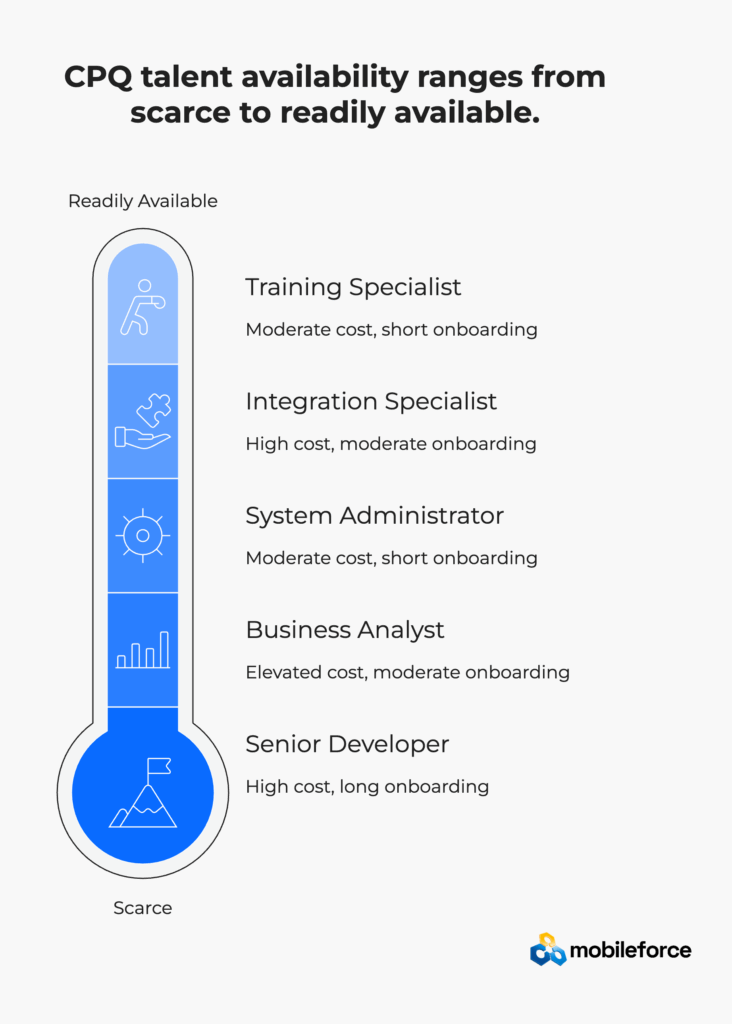
Market responsiveness defines competitive advantage, but legacy CPQ systems create significant barriers to new product introduction and user experience optimization for sales teams and customers.
The product launch bottleneck begins with configuration requirements. Legacy systems often require extensive rule development and testing to accommodate new products, bundles, or pricing models. What should be a weeks-long process stretches into months as teams navigate complex configuration requirements and ensure existing functionality remains intact.
Benchmarking data reveals that organizations with legacy CPQ systems typically require 4-6 months to fully onboard new product lines, compared to 4-8 weeks for modern CPQ platforms. This delay directly impacts revenue potential and market competitiveness for product launch timelines.
The user experience deterioration compounds over time. Legacy systems developed before modern UX principles often feature cumbersome interfaces that slow sales processes and increase error rates. Training requirements escalate as new features get bolted onto existing frameworks rather than integrated seamlessly.
Metric | Legacy CPQ | Modern CPQ | Impact |
Quote Generation Time | 45-90 minutes | 15-30 minutes | 60-67% reduction |
New User Training | 40+ hours | 8-16 hours | 60-80% reduction |
Error Rate | 8-12% | 2-4% | 67-75% improvement |
User Satisfaction Score | 6.2/10 | 8.7/10 | 40% improvement |
The mobile experience gap becomes particularly costly as field sales teams increasingly require on-device quoting capabilities. Legacy systems designed for desktop use often lack mobile optimization, forcing sales representatives to delay quotes until they return to the office.
Customer experience suffers when legacy systems generate unprofessional quote formats or lack real-time pricing accuracy. Professional-looking, accurate quotes reinforce brand credibility and accelerate deal progression. Forrester research on digital customer experience shows that companies with superior customer experience grow revenues 1.7x faster than laggards for customer retention and acquisition.
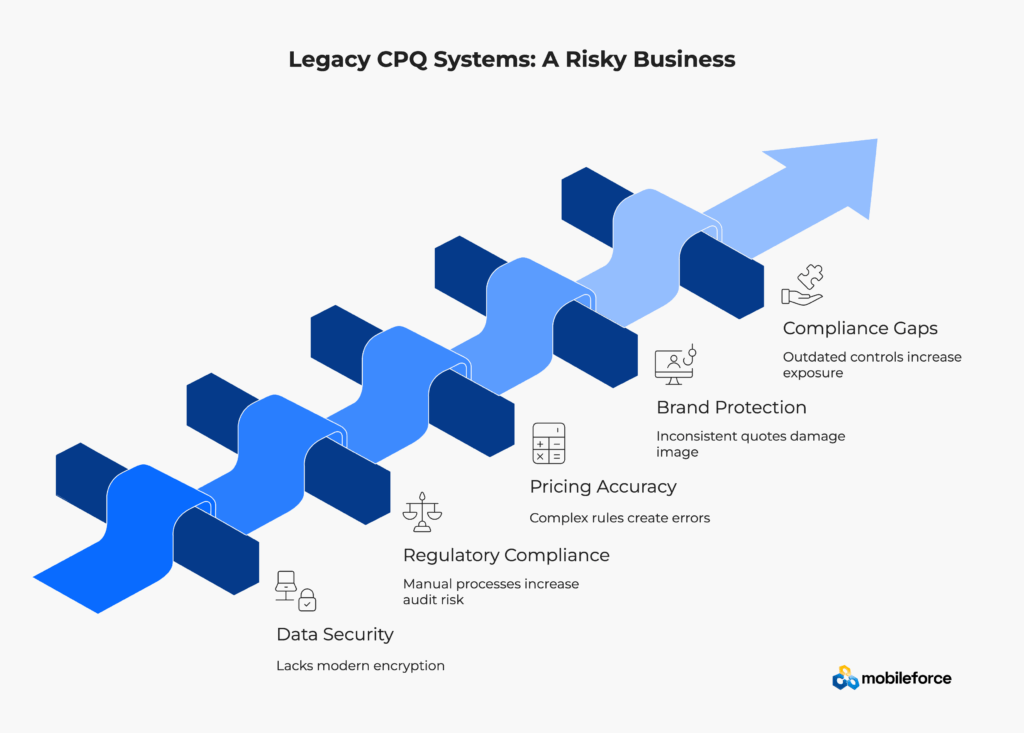
Risk multiplies exponentially in legacy CPQ environments where security patches lag, regulatory updates stall, and audit trails disappear into system complexity.
The security vulnerability window widens as legacy systems age. Vendors reduce support for older versions, leaving organizations responsible for security maintenance without access to timely patches. IBM’s Cost of a Data Breach Report indicates that the average cost of a data breach involving customer pricing information can easily exceed $4.45 million – far more than the total CPQ system investment.
Compliance challenges multiply across industries. Financial services organizations need SOX compliance for pricing approvals. Healthcare companies require HIPAA protections for customer data. Manufacturing firms must maintain audit trails for government contracts. Legacy systems struggle to provide comprehensive compliance frameworks without significant custom development.
Brand risk emerges through pricing errors and quote inconsistencies. Research indicates that organizations with legacy CPQ systems experience margin leakage exceeding 2% annually due to quoting mistakes and approval bypasses. These errors erode profitability while damaging customer relationships.
Risk Category | Legacy CPQ Impact | Annual Cost Range | Mitigation Difficulty | Business Impact |
Data Breach | High vulnerability | $2M-5M+ | Very High | Severe |
Regulatory Fines | Audit trail gaps | $100k-1M | High | Significant |
Pricing Errors | Manual processes | $50k-500k | Medium | Moderate |
Brand Damage | Quote inconsistency | $25k-250k | Low | Variable |
Compliance Gaps | Outdated controls | $75k-750k | High | Significant |
The liability exposure extends beyond immediate financial impact. Pricing errors can trigger customer disputes, regulatory investigations, and competitor intelligence gathering that damages long-term market position.
Modern CPQ platforms address risk through built-in security frameworks, automated compliance reporting, and comprehensive audit trails that reduce both financial exposure and operational complexity.

The CPQ vendor landscape reveals significant gaps between legacy solutions and modern business requirements for enterprise software selection. Understanding these limitations helps organizations evaluate replacement options more effectively.
Traditional CPQ vendors often burden customers with extensive professional services requirements and lengthy implementation timelines for CPQ software implementation. User review analysis from platforms like G2 and Capterra consistently highlights these pain points:
Home-grown CPQ systems face inevitable scalability and maintenance challenges for custom software development. While initial development may seem cost-effective, the total cost of ownership typically exceeds commercial solutions within three years.
The innovation gap widens as internal development teams focus on maintenance rather than feature advancement. Commercial CPQ vendors invest millions annually in platform enhancement, while internal teams struggle to keep pace with basic functionality requirements for software feature development.
G2’s CPQ software comparison data consistently rates modern CPQ solutions higher for ease of use and functionality while criticizing legacy alternatives for excessive costs and limited configuration support. Users particularly value platforms that deliver rapid deployment with minimal professional services requirements.
Modern CPQ platforms address these shortcomings through no-code configuration tools, accelerated deployment methodologies, and comprehensive integration capabilities that reduce total cost of ownership while improving business agility. Explore Mobileforce’s approach to modern CPQ and see how it differs from traditional solutions.
Ready to escape legacy CPQ limitations? Explore modern alternatives that deliver faster implementation and lower total cost of ownership.
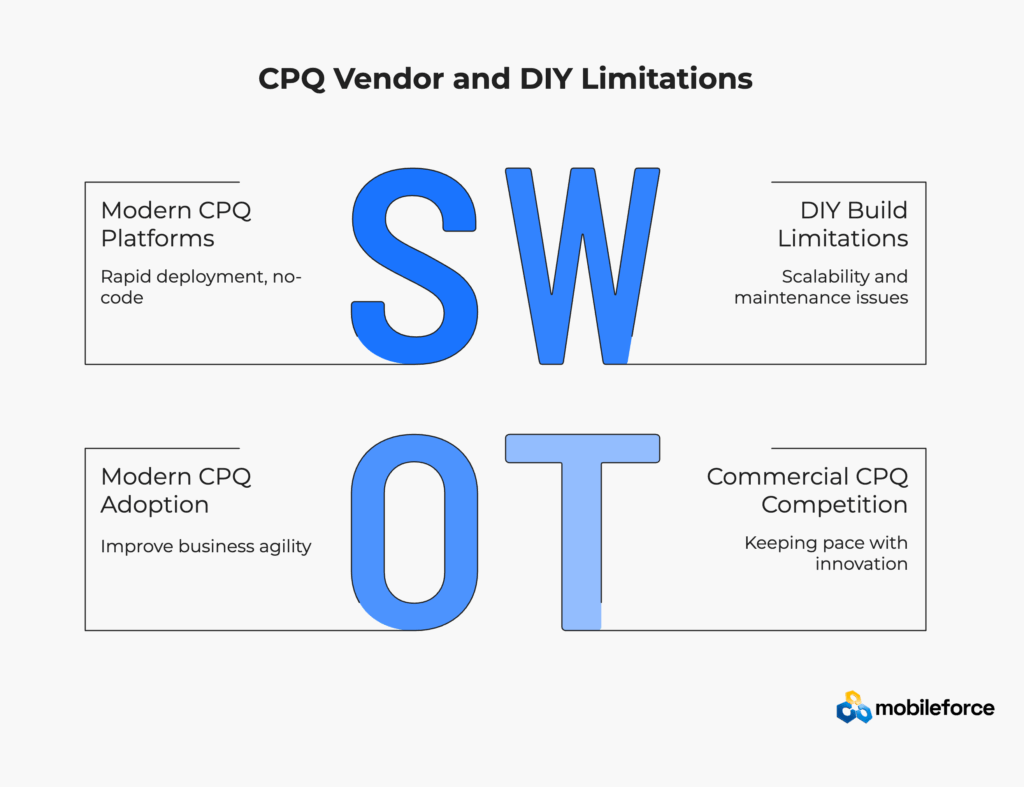
Quantifying hidden costs requires systematic evaluation across multiple dimensions. This diagnostic framework helps organizations build baseline measurements for CPQ investment decisions.
Organizations should compile monthly totals across these categories to establish true CPQ cost of ownership. Most discover that hidden costs exceed visible expenses by 40-60%, providing clear justification for modernization investments.
The assessment process typically reveals optimization opportunities worth 15-25% of current CPQ spending while identifying capability gaps that limit revenue growth potential.

Modern CPQ platforms must address legacy system limitations while providing foundation for future business growth. Key capabilities define successful modernization outcomes.
Cloud-Native Architecture: Eliminates infrastructure maintenance while providing automatic scaling and global accessibility. Modern platforms deliver 99.9% uptime with built-in disaster recovery capabilities.
No-Code Configuration: Enables business users to modify pricing logic without technical expertise. Visual rule builders reduce configuration time by 70-80% while improving accuracy.
API-First Integration: Supports real-time data synchronization across business systems through standardized connectors and open APIs.
Mobile-Optimized Experience: Provides full quoting functionality across devices with offline capabilities for field sales scenarios.
Advanced Analytics: Delivers comprehensive quote-to-cash reporting with AI-driven insights for pricing optimization.
Guided Selling Tools: Improves sales productivity through intelligent product recommendations and automated pricing calculations.
Leading platforms like Mobileforce deliver comprehensive CPQ capabilities through no-code configuration tools that support complex pricing rules, large product catalogs, and hybrid cloud/offline quoting scenarios. One-click integrations with major CRM and ERP systems eliminate custom development requirements while providing real-time data synchronization.
The platform approach reduces implementation time from months to weeks while delivering immediate productivity improvements and cost reductions across the entire quote-to-cash process. Learn more about Mobileforce’s unified RevOps platform and its comprehensive capabilities.
Tired of lengthy CPQ implementations and ongoing maintenance headaches? Schedule a demo to see how modern platforms deliver value in weeks, not months.

Real-world implementation results demonstrate the tangible benefits of modern CPQ platform adoption. SportSafe, a UK-based sports equipment supplier and installer, exemplifies successful legacy system replacement.
SportSafe operated complex quoting and service workflows across sales and field service teams with significant overlap and coordination challenges. Their existing quoting and inspection processes created extended timelines that impacted customer satisfaction and revenue acceleration.
The legacy system required manual coordination between sales representatives generating quotes and field service teams conducting installations and inspections. This disconnect created version control issues and communication gaps that extended project timelines.
SportSafe implemented Mobileforce’s unified RevOps-as-a-Service platform, integrating CPQ and field service management capabilities through a single solution. The unified approach eliminated data silos while streamlining workflows across both sales and service delivery functions.
Key implementation components included:
SportSafe achieved an 80% reduction in quote and proposal generation time, significantly improving their sales cycle velocity and customer response capabilities. The improvement impacted both initial sales processes and ongoing service delivery cycles.
The unified platform eliminated manual handoffs between sales and service teams while providing comprehensive visibility into project status and resource utilization. Customer satisfaction improved through faster response times and more accurate project coordination.
The SportSafe case demonstrates how modern CPQ platforms deliver value beyond traditional quoting functionality. Integrated approaches that connect sales and service processes provide compound benefits that exceed individual system optimization efforts.
Organizations considering CPQ modernization should evaluate solutions that address broader business process integration rather than point solutions that perpetuate system silos.
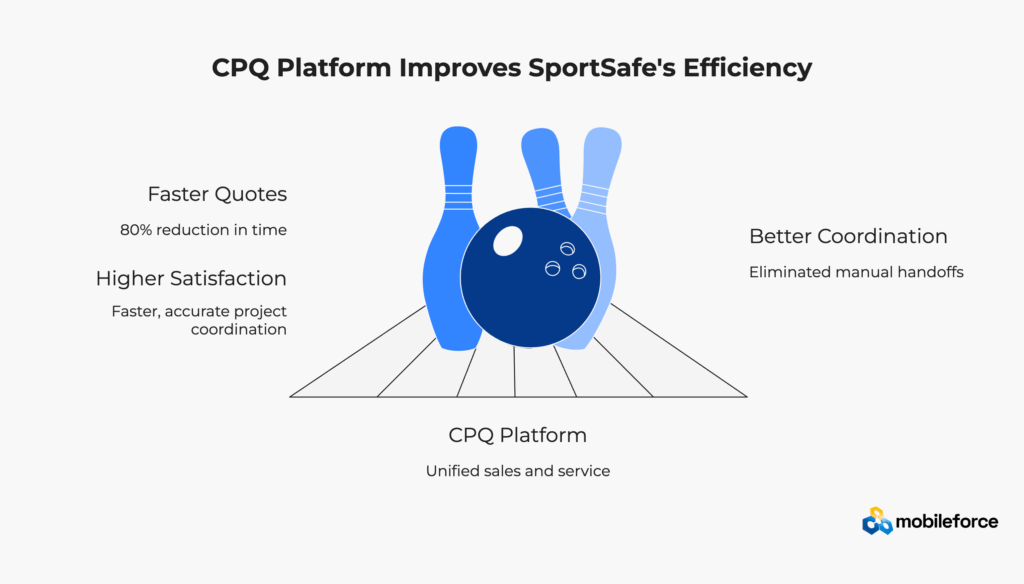
Successful CPQ modernization requires structured approach that minimizes business disruption while maximizing implementation speed and adoption rates.
The structured approach typically delivers initial productivity benefits within 30 days while achieving full optimization within 90 days of go-live.
Phase | Duration | Internal Resources | External Resources | Key Deliverables | Success Metrics |
Assessment & Planning | 4 weeks | 2-3 FTE | Consultant team | Requirements doc, vendor selection | Stakeholder alignment |
Core Configuration | 8 weeks | 3-4 FTE | Implementation team | Configured system, integrations | User acceptance testing |
Pilot Deployment | 4 weeks | 2-3 FTE | Support team | Pilot results, refined processes | User feedback scores |
Full Production | 4 weeks | 4-5 FTE | Support team | Live system, training complete | Adoption rates >80% |
Total Timeline | 20 weeks | Peak: 5 FTE | Varies by phase | Production system | ROI positive |
Ready to begin your CPQ modernization journey? Schedule a strategic assessment to develop your customized implementation roadmap.

ROI calculations for CPQ modernization typically show positive returns within 12-18 months through multiple value streams that compound over time.
Category | Annual Savings | 3-Year Total |
Maintenance Reduction | $150,000 | $450,000 |
Integration Elimination | $75,000 | $225,000 |
Support Staff Optimization | $100,000 | $300,000 |
Error Reduction | $50,000 | $150,000 |
Modern CPQ platforms enable business capabilities that generate long-term competitive advantages beyond immediate cost savings. Data analytics provide pricing optimization insights, while API capabilities support future business model innovations.
The investment payback typically accelerates in year two as organizations optimize processes and expand platform utilization across additional business functions. McKinsey’s research on digital ROI shows that companies with integrated digital platforms achieve 2-3x higher returns than those with point solutions.

CPQ modernization provides foundation for broader digital transformation initiatives that extend beyond immediate quoting requirements.
Modern platforms support AI-powered pricing recommendations, machine learning-driven forecasting, and automated approval workflows that continuously improve business performance.
API-first architectures enable integration with emerging business applications including e-commerce platforms, partner portals, and customer self-service tools. Discover how Mobileforce’s integration capabilities support comprehensive business ecosystems.
Cloud-native platforms automatically scale with business growth while providing global deployment capabilities that support international expansion.
The strategic approach positions organizations for sustained competitive advantage through technology platforms that evolve with business requirements rather than constraining future growth options.

Legacy CPQ systems represent more than outdated technology – they’re anchors that drag down business performance while hidden costs compound silently. The seven cost categories outlined here typically add 40-60% to visible CPQ expenses while limiting growth potential and competitive responsiveness.
Organizations can’t afford to keep patching legacy quoting engines while competitors sail ahead with modern platforms. The window for competitive advantage through CPQ modernization narrows as market leaders establish operational superiority through superior quote-to-cash capabilities.
The time for CPQ transformation is now. Every month spent maintaining legacy systems represents opportunity costs that compound across sales cycles, product launches, and market expansion initiatives. Modern CPQ platforms don’t just reduce costs – they enable revenue acceleration and competitive differentiation that drives sustainable business growth.
For organizations seeking agility, accuracy, and scalability in their quoting processes, modern CPQ solutions offer a future-proof path that transforms cost centers into revenue accelerators.
Ready to escape the legacy CPQ cost trap? Schedule your comprehensive assessment today and discover how modern CPQ platforms can transform your quote-to-cash performance while reducing total cost of ownership.
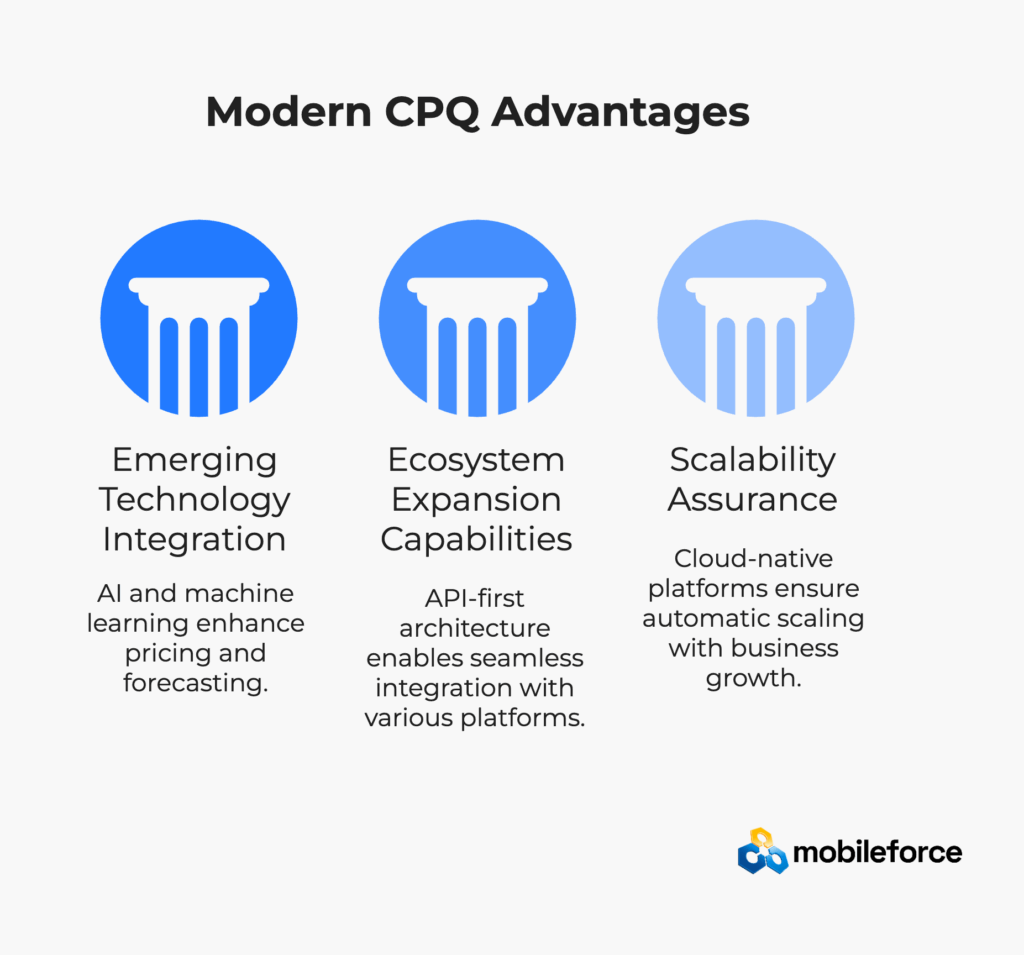
Modern CPQ implementations typically complete within 12-20 weeks, compared to 12-18 months for legacy system replacements. The accelerated timeline results from pre-built integrations, no-code configuration tools, and cloud deployment capabilities that eliminate infrastructure setup requirements. Gartner’s implementation research confirms that cloud-native solutions reduce implementation time by 50-70% for software deployment projects.
Organizations typically achieve positive ROI within 12-18 months through combined cost savings and revenue acceleration benefits for CPQ software investment returns. Direct cost reductions often appear within 90 days, while revenue improvements compound over the first year as sales processes optimize and quote-to-cash efficiency improves.
Advanced CPQ platforms support multi-dimensional pricing matrices, dynamic discount calculations, and approval workflows through visual rule builders that enable business users to configure complex logic without programming expertise for pricing rule management. Testing environments validate rule interactions before deployment to ensure pricing accuracy and system reliability.
Leading CPQ platforms provide pre-built connectors for major CRM, ERP, and billing systems with API-first architectures that support custom integrations for business system connectivity. Real-time data synchronization eliminates manual data entry while maintaining consistency across business systems for sales process automation.
Successful adoption requires comprehensive training programs, change management support, and phased rollout approaches that minimize business disruption for CPQ implementation success. Modern platforms’ intuitive interfaces typically reduce training requirements by 60-80% compared to legacy systems while improving user satisfaction scores.
Enterprise CPQ platforms include SOC 2 compliance, data encryption, role-based access controls, and comprehensive audit trails for enterprise security requirements. Industry-specific compliance features support financial services, healthcare, and government contracting requirements for regulatory compliance.
Advanced platforms provide full quoting functionality across devices with offline capabilities for field sales situations and mobile sales scenarios. Mobile-optimized interfaces enable quote generation, product configuration, and customer presentations without internet connectivity for field sales productivity.
Comprehensive cost assessment includes license fees, maintenance costs, integration expenses, internal support staff time, error correction costs, and opportunity costs from delayed sales cycles for total cost of ownership analysis. Hidden costs typically represent 40-60% of total ownership expenses beyond visible budget line items.
Modern CPQ platforms include data migration tools that preserve historical quote information, customer preferences, and configuration settings for data continuity. Automated migration processes minimize manual data entry while maintaining data integrity throughout the transition for business continuity.
Vendor evaluation should focus on implementation speed, total cost of ownership, integration capabilities, mobile functionality, and long-term platform evolution for CPQ vendor selection. Reference customers in similar industries provide valuable insights into real-world implementation experiences and ongoing support quality for software vendor assessment.